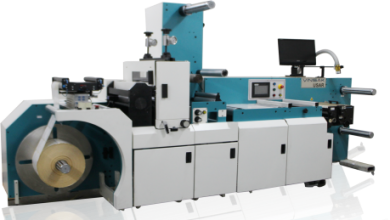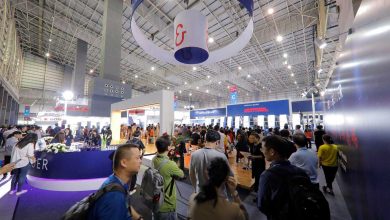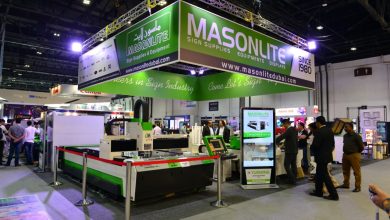drupa celebrates 65 years Back to the future of print
By Ed Boogard, Netherlands
Self-tying shoelaces and a self-drying jacket? Flying cars and hoverboards? Many of the unlikely predictions for the year 2015, made in the 1989 blockbuster movie Back to the Future II, proved incorrect. But it got at least one thing right: people are, indeed, still reading printed newspapers as we are about to celebrate 65 years of drupa (and totalling 225 Messe-days!). Gearing up towards this 16th edition, we invite you to get in that imaginary modified DeLorean, get it up to 88 miles per hour on the Autobahn heading for Duesseldorf – and go way back to the future of print.
 “Drupa has been tried and tested – and has never failed to impress”, stated Werner Matthias Dornscheidt, President & CEO of Messe Duesseldorf, two years ago. Putting the new slogan ‘Touch the Future’ to practice, he added: “And drupa 2016 will be no different.” Based on the events’ rich history, his forecast is very likely to come true. But back in 1949, it takes the founding fathers of drupa a lot of courage to come up with this completely new concept: an international trade show for capital goods for the printing and paper industry, to be held in 1951. Only after signing up 527 exhibitors from 10 countries and welcoming over 300,000 visitors, they know they are on to something big.
“Drupa has been tried and tested – and has never failed to impress”, stated Werner Matthias Dornscheidt, President & CEO of Messe Duesseldorf, two years ago. Putting the new slogan ‘Touch the Future’ to practice, he added: “And drupa 2016 will be no different.” Based on the events’ rich history, his forecast is very likely to come true. But back in 1949, it takes the founding fathers of drupa a lot of courage to come up with this completely new concept: an international trade show for capital goods for the printing and paper industry, to be held in 1951. Only after signing up 527 exhibitors from 10 countries and welcoming over 300,000 visitors, they know they are on to something big.
Drupa City
The organizers aim to build upon the traditional BUGRA exhibition (short for ‘Buchgewerbe und Graphik’), held in Leipzig since 1914. With Germany partitioned in 1949 and Leipzig behind DDR-borders, it is necessary to restructure the country’s exhibition landscape as well. In May 1950, they officially announce Duesseldorf as the city to host the first ‘Internationale Messe Druck und Papier’ – a title that in practice is soon shortened to ‘Druck und Papier’, and then to ‘DRUPA’. That name is officially adopted in 1950 – in spite of the fact that only few at the table actually like the abbreviation very much, alternatives like ‘INDRUPA’ are discarded. A design contest brings the show its iconic logo, representing a printing tampon. It will be in use for the next 50 years, only to be replaced in the year 2000 by the ‘pixel’-logo.
Lines of type
In 1951, letterpress rules the industry. For the last century, both typesetting and printing have been industrialized rapidly, and drupa shows the way forward. Visitors can see five different Linotype models and also five Monotype-machines feeding lines of type to the multitude of presses that are on display from the factories like Koenig & Bauer, M.A.N., Frankenthal Albers & Cie and Heidelberg. The latter has no less than 19 presses running live at the show, including both its Automatic Platen letterpress and Cylinder press. Speed and automation are definitely the buzzwords in Duesseldorf – as they will continue to be for the next 65 years. German newspaper Die Zeit reviews the debut of the event as “an excellent achievement” – despite the “at first sight somewhat confusing combination of Print and Paper under one roof”.
Print-ready stereotype
Change is in the air. Offset, already on the rise in the USA as run lengths get bigger and demand for colour is growing, is on display at various booths in 1951. Faber & Schleicher, for instance, demonstrates its latest offset presses at Hall 11: the single colour Roland Parva and the two colour Roland Ultra. (At home in Augsburg, M.A.N. is starting up construction of its first sheetfed offset press ‘Ultra M.A.N.’)
Other inventions, that are bound to change the industry at some point in time, are also taking shape – almost simultaneously. For example in the USA, Xerox installs its first plane paper copier ‘914’. Siemens patents the first continuous-stream inkjet printer. And in the labs of Rudolf Hell (inventor of the Hellschreiber, a 1925-version of the fax machine), tests are running on the Klischograph; an electronically controlled engraver that scans a film to a print-ready stereotype (or ‘cliché’) in one go.
Speed up prepress
Only three years later, 1954, drupa stages its second edition for another 16 days at nearly double the size: 35,000 sqm. The introduction of the Hell Klischograph 151 is a success, as it enables printers to replace the time-consuming chemical-etching process and thus speed up prepress production. The same goes for the Linotype Quickset System, the first punched-tape controlled typesetter of its kind boasting a casting output of some 18,000 characters per hour. As a way of showing off the industries capabilities, the visiting Federal President Theodor Huess can see his photograph already in printed form only some 30 minutes after it was taken.
Imaging instead of casting
As our DeLorean-time machine arrives in 1958, we see offset is clearly gaining more and more traction. The growing success of its Roland presses even convinces Offenbach-based factory Franken & Schleicher to change its name to ‘Roland Offsetmachinenfabrik Franken & Schleicher’. Meanwhile, at Heidelberg the offset technology is still being discussed ‘with a scepticism bordering on dismissal’.
Photocomposition is well on its way to replace hot metal. Monotype has its Monophoto – a converted mechanical hot-metal machine that is now imaging instead of casting characters. Berthold shows a prototype of its Diatype in 1958. It is a desktop system for fast typesetting of headlines, using characters on a glass master disc. Hell launches its Colorgraph, a flatbed system able to scan, convert and correct original photos into color separations.
Linotype further speeds things up. It has been working on its Linofilm phototypesetting machine, fitted with an electronic flash tube, since last drupa. After field tests at the Daily News in New York in 1956, the machine (‘consisting of a keyboard, automatic photocomposition unit and correction and assembly devises’) is presented in Düsseldorf, capable of outputting 43,000 characters on film per hour.
Letterpress converts to offset
Heidelberg makes up its mind: at the fourth edition of drupa, in 1962, it enters the offset market by presenting the KOR – a letterpress converted to offset. The Messe-halls, now covering 48,000 sqm, are filled with new offset presses from various manufacturers, including Wifag. Also, from Japan, Sakurai joins the trade show for the first time showing its flatbed letterpress, while Screen starts marketing its first electronic colour scanner.
For the first lustrum edition of drupa, in 1967, two temporary halls are added to the fair, some five kilometres north from the actual exhibition centre. But even at 60,000 sqm, the show is sold out. Koenig & Bauer celebrates its 150 years anniversary and presents the new ‘Rapida’ series of sheetfed offset presses. And Hell’s Kombi-Chromagraph CT288 is able to combine several scans to put images and texts together on film.
New halls
One year after the fifth drupa, Duesseldorf decides to build a completely new exhibition centre – exactly on the spot where the temporary 1967-halls were – to allow its major trade fairs to grow even further. So, in 1972, drupa has some 100,000 sqm available – and sells out again. A major shift in the industry is taking place. The production of Linotype hot-metal machines in the USA has been discontinued in 1970. At the same time, Heidelberg introduces its GTO (‘Grosser Tiegel Offset’) press, while the Roland 800 is the first offset-press to have an integrated ink control system.
For the first time in its history, drupa has more than 1,000 exhibitors in 1977. Prepress has gone electronic all the way – with Crosfield adding its minicomputer-controlled Magnascanner. Heidelberg launches its first Speedmaster-presses. UV-inks are introduced, and the first waterless printing offset-plates are on show. Also, the Compugraphic EditWriter 7500 is introduced: ‘a phototypesetter combining a keyboard and photo unit in one piece of equipment, enabling one job to be typeset while the operator simultaneously keyboards another.’ Meanwhile, in Israel, a man called Benny Landa founds a company by the name of ‘Indigo’ to work on perfecting liquid toner-technology. The 1982-edition of drupa – with half of exhibitors coming from outside Germany – sees further phototypesetting developments as, for example, Scangraphic launches its Scantext1000 system.
Digital show
“Drupa, drupa, international printing and paper fair, we welcome you to Düsseldorf, Germany, to see what’s new in the graphics industry”. This first drupa-song marks the 1986 edition of the show, although it was already used in 1980 for the first time to promote the 1982-fair during the Print’80 show in Chicago.
 What’s really new is that further change is on its way: Apple has launched its first desktop computer (in 1984), and Adobe has started to develop PostScript. Linotype celebrates its 100th anniversary.
What’s really new is that further change is on its way: Apple has launched its first desktop computer (in 1984), and Adobe has started to develop PostScript. Linotype celebrates its 100th anniversary.
At its 10th edition and 40th birthday, drupa 1990 is proclaimed the ‘digital show’. With some 25 running web offset presses in the drupa halls. Now covering a total of over 126,000 sqm, there is also room for, for example, AM’s liquid toner-based ElectroPress. As the fair takes place shortly after the Iron Curtain has come down in 1989, it also allows for talks between KBA and Planeta, and between M.A.N. and Vomag. Offset continues to raise the stakes, with Komori introducing the world’s first automatic plate change system, “perceived as a redundant luxury solution at that time”.
Boosting our ‘Mr. Fusion Home Energy Reactor’-powered DeLorean five years on, it is all about improved productivity at the drupa 1995. Computer-to-plate (CtP), DI-presses and digital colour printing are all over the place. While Indigo shows off its E-Print 1000 digital offset colour press, Xeikon demonstrates its DCP-1 dry-toner press.
Apple is there to demonstrate prepress solution on its Power Mac-platform. Heidelberg has its Quickmaster-DI in place. MAN Roland protoypes the DICO-press. And press-manufacturer KBA is shows inkjet on a ‘hybrid’ offset web press, adding the capability to print a variety of cartoons on the front page of each and every newspaper.
From Gutenberg to Internet
The 600th birthday of Gutenberg marks the 2000-edition, celebrating 50 years of drupa. Full colour digital printing is now seriously taking on offset, with Xerox exhibiting at an entire hall its DocuColor system (and previewing its ‘FutureColor’ system), Heidelberg and Kodak jointly introducing NexPress, and Karat launching its Karat74 DI press. But not only printing is set to go digital – the entire production workflow becomes connected from prepress to afterpress through the industry standard CIP3, as shown in practise in Hall 6 by the PrintCity-consortium. Even Apple is taking part, as it decides to skip CeBIT and attend drupa instead to lure back professional users. It previews OS-X. And there is this thing called ‘Internet’, that everybody is talking about.
At drupa 2004, the Job Definition Format (JDF) becomes the symbol of the interconnected digital workflow in graphic production. While celebrating the 150th birthday of Ottmar Mergenthaler, inventor of the Linotype, the industry continues towards further digitization. In 2008, ever more digital printing is added to the list of exhibitors: Océ, Canon, Agfa, Ricoh and Konica Minolta have toner-technology in place, while Kodak, Screen and HP also start showing inkjet as the next big thing. As the show draws to end, news from San Francisco reaches Duesseldorf: Apple launches its iPhone 3G.
Touching the future
In 2012, Benny Landa takes inkjet to the next level by promising nanographic-printing for drupa 2016. Conventional press manufacturers like KBA and Heidelberg work on their own inkjet-devices, just like almost every digital press manufacturer does. As we accelerate towards an Industrie 4.0 era, speed and automation are once again the buzzwords in Duesseldorf during drupa 2016, together with efficiency, effectiveness, interactivity and multi-channel. And as we hum the new drupa song, rumour has it that a Back to the Future-sequel will be performed later this year as a musical at a London West End theatre.





